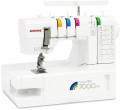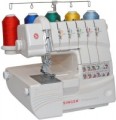Type of sewing machine
The type of sewing machine determines its functionality and specific application.
—
Electromechanical. The classic, most simple kind of sewing machines: they do not have computer control, all work parameters are adjusted mechanically, and the use is limited to the simplest types of seams.
—
Computerized. Sewing machines are equipped with built-in computers that control the sewing process. Because of this, they have a more extensive feature set and are more accurate in settings than electromechanical ones, although they cost accordingly. Note that only computerized sewing machines are meant; embroidery and sewing-embroidery machines are separated into separate categories (see relevant paragraphs).
—
Embroidery. Such machines were originally intended only for embroidering patterns, and are practically not suitable for work outside this specialization (ordinary sewing, hemming). They have the appropriate design features, are equipped with embroidery hoops and feet for embroidery, are often equipped with both a set of built-in presets (for example, embroidering letters of the alphabet), and can connect to a PC and download patterns.
—
Sewing and embroidery. Machines that can be used for both sewing and embroidery. In terms of design and sewing capabilities, they are similar to computerized models (see t
...he relevant paragraph) but are supplemented with an embroidery unit, hoops and other embroidery equipment. And the built-in features usually include basic embroidery elements (crosses, stars, satin stitch, etc.), as well as the ability to embroider according to patterns downloaded from a computer. Such machines are very versatile, but in terms of specific capabilities, they may be inferior to more specialized models.
— Overlocker. A special type of sewing machine designed primarily for seaming and trimming the edges of materials. Overlocker overcasts the edge of the fabric with a special seam, which prevents fraying, shedding and deformation. One of the design features of such devices is the presence of several working threads, from 2 to 10 (most often 3 or 4).
— Coverstitch. Devices designed to create cover stitch — a flat, stretchy seam that is most commonly used for hemming a folded edge in knitwear, as well as in some types of joins. For other purposes, such machines are not used.
— Coverlock. Devices that combine an overlocker and a coverstitch machine in one case. For more information about each of these varieties, see the relevant paragraph. Here we note that the coverlock is a universal tool for processing edges: it can overcast them, cut off the excess fabric and hem the folded edge with a cover stitch. In addition, many modern coverlock are also capable of seaming materials (mainly with a double chain stitch).Number of stitches
The number of stitches that a sewing machine can sew. The larger this number, the more extensive the capabilities of this model, the wider the choice the user has; however, it wouldn’t hurt to clarify the specific range of supported stitches separately.
The fewest options - mostly up to 25 - are provided in electromechanical machines, as well as specialized devices such as overlockers and carpet lockers (see “Type”). In computer-controlled devices, the number of lines can be in the dozens, and some also allow you to download additional options from the computer.
Max. stitch width
The maximum stitch width provided by a sewing machine.
Most modern sewing machines are capable of working not only with the simplest longitudinal seam (when punctures with a needle occur strictly one after another), but also with seams that cover a certain width - for example, zigzag and various decorative ones. And in overlockers, such opportunities are generally available by definition.
The larger the maximum stitch width, the correspondingly wider the machine’s ability to work with specific types of seams (all other things being equal). An indicator of up to 5 mm is typical mainly for entry-level devices, 5 - 7 mm - average, 7 mm and more - advanced.
Max. presser foot height
It is the distance from the work surface to the presser foot in the highest position. It must be taken into account when working with thick fabrics.
Sewing speed
The maximum sewing speed provided by the sewing machine. In the vast majority of models, this parameter can be adjusted, so that, if necessary, you can sew at a lower speed.
The more stitches per minute the machine makes, the higher its productivity, and the better it is suitable for large volumes of work. At the same time, note that high speed has a corresponding effect on price and power consumption, and it is not always required. Detailed recommendations on choosing the optimal speed for certain types of work can be found in special sources.
Presser foots
Types of presser feet supplied with the sewing machine.
— Universal foot. A foot is used for standard sewing, mainly straight stitches and zigzags.
—
Overlock foot. A foot designed for overlocking. By definition, it is found in devices with an overlock function (see “Type”). However, it can also be provided in traditional sewing machines. In the latter case, such a foot, of course, will not replace a full-fledged overlocker, but in some situations it allows you to work without it.
—
Top feed or walking foot. An additional top-mounted feed dog in place of the stock foot, in addition to the standard bottom feed dog. Such a device makes it easier to work with thin, delicate and sliding fabrics, as well as sewing together several layers of fabric: the material moves as evenly as possible, without distortions and displacements.
—
Zipper foot. The foot for sewing in a zipper can have a different size and design — in particular, there are special devices for sewing in a hidden zipper. The specific features of this device should be clarified separately.
—
Decorative stitch foot. Feet designed for various types of decorative stitching. Such a line may not have a functional role. Its main task is to emphasize a certain element of clothing (edges, pockets, individual seams, etc.). Anyway, the stit
...ch line should usually strictly follow the contour along which it is applied — and this contour can consist of both straight lines and curved lines. Special feet for decorative stitching simplify the task: they are equipped with rulers or other devices that allow you to control the parallelism of the stitches.
— Satin stitch foot. This foot will be suitable for appliqué and other work where zigzag stitches are often used.
— Blind hem foot. Foot designed for blind seams used when hemming the edge of the fabric. It is equipped with a device that provides a hem of the fabric and in this position feeds it under the needle.
— Quilting foot. Special feet for quilting — patchwork. In such works, it is necessary to sew the fabric in several layers, as well as to perform figured seams. In extreme cases, you can use the usual universal foot for quilting, but using a special device is still much more convenient.
— Monogramming foot. The foot for embroidery of monograms will allow you to make embroidery on any object, thereby decorating it with your signature or the emblem of any institution, company, or sports club.
— Buttonhole foot. Buttonhole foot. It eliminates the need for manual work. The sewing machine will do everything for you, which will reduce your time and please you with quality.
— Button sewing foot. A foot is designed to hold the button on the fabric while sewing on. It has a special protrusion pointing down: when the main part of the foot is pressed against the button, this protrusion presses the fabric and prevents it from slipping.
In addition to the above, other types of feet may be included in the delivery kit.Led lighting
A built-in lighting system that illuminates the working table of the machine, which is made of LEDs. In addition to the bright illumination of the work area,
LED-light sewing machines also have lower energy consumption compared to classic lamps.
Power consumption
The power consumed by the machine during operation. Usually, the maximum power value is indicated in the characteristics.
Most of the electricity supplied to the machine is consumed by the engine, so this indicator primarily describes the power of the engine. The higher this power, the faster the machine can work and the better it is suitable for working with dense fabrics. However, there is no strict dependence here, much also depends on the general specialization of the unit.

